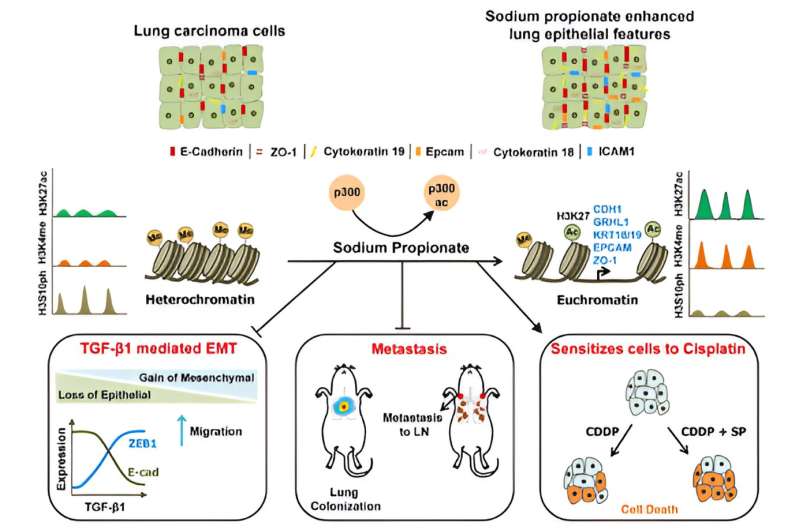This article has been reviewed according to Science X's editorial process and policies. Editors have highlighted the following attributes while ensuring the content's credibility:
fact-checked
peer-reviewed publication
trusted source
proofread
Study points to new possibilities for treating lung cancer patients

Currently, researchers from different institutions in the world are testing a drug against obesity and diabetes, and now a Danish led research team reports that the same substance has had a beneficial effect on mice with experimental lung cancer.
The substance is the short-chain fatty acid propionate, which is naturally produced by bacteria in our gut. From there, it is distributed throughout the body, and this new research study shows that treating mice with lung cancer with propionate can reduce the occurrence of metastases.
The study also demonstrates a role for propionate in increasing the effectiveness of Cisplatin, a commonly used drug for lung cancer patients. This was shown by lab experiments carried out in cancer cells derived from patients.
"Our main message is that we have a substance here that is not harmful—we already produce it in our bodies via the gut digestion process—and that could be tested for metastases prevention," says Associate Professor and Head of Research, Paolo Ceppi from the Department of Biochemistry and Molecular Biology, University of Southern Denmark (SDU), and the lead author of the new study.
The experiments were conducted by Dr. Vignesh Ramesh, a postdoctoral researcher at SDU, and the study involved other researchers from SDU, as well as collaborators from University of Torino in Italy and University of Heidelberg in Germany. The new research is published in the EMBO Molecular Medicine journal.
The researchers are now seeking funding for the next step: To identify patients that will potentially respond well to propionate treatment and after that, initiate clinical trials, i.e. testing the substance on lung cancer patients.
"This is necessary because we can simulate tumors in the mice very well, but they have a lower genetic complexity than what is observed in the patients, therefore it is extremely important to be able to identify upfront the patients that may be best benefiting from a novel therapy," says Associate Professor Paolo Ceppi.
The reason cancer can spread to other parts of the body is that cancer cells from a tumor can be carried through the bloodstream or lymphatic system and form new cancerous growths, also known as metastases. Cancer cells can metastasize to other organs by hijacking a program that exists in a normal physiology.
One of these programs is called EMT (epithelial-mesenchymal transition), which existed even when we were still embryos. Its purpose was to ensure that newly formed cells could move to the right places and differentiate to different organs.
Data from almost 1,500 patients
"Cancer cells rarely invent anything new by themselves. They use what already exists in nature, and in this case, they hijack the embryological EMT program to move around," explains Paolo Ceppi.
In their new study, the researchers analyzed data from lung cancer patients and conducted lab experiments on mice and human cells.
The dataset, originating from nearly 1,500 patients, provided the researchers with metabolic and genetic data. Here, they discovered a correlation between genetic signs of cellular propionate and the effectiveness of the EMT program: an activation of propionate-related genes coincided with low EMT efficiency. EMT efficiency is significant in allowing cancer cells to spread through the EMT program: the more efficient it is, the better it is at helping cancer cells move around the body.
The second part of the evidence in their study is the results from mouse experiments. Among others, they conducted an experiment with two groups of mice in which they have induced lung cancer. One group received propionate in their drinking water (group A), while the other group did not (group B).
When the cancer-stricken mice died naturally after a month or two, they were examined for metastases. In group A, 20 percent of the mice had developed metastases, while in group B, 60 percent had metastases.
"At the moment, there is no medication that can block the EMT program and thus prevent the formation of metastases. But propionate, which has shown promising results in our experiments, is already being tested in clinical trials to see if it can help with obesity or diabetes. It is logical to begin testing it on lung cancer patients as well," says Paolo Ceppi.
More information: Vignesh Ramesh et al, Propionate reinforces epithelial identity and reduces aggressiveness of lung carcinoma, EMBO Molecular Medicine (2023). DOI: 10.15252/emmm.202317836



















